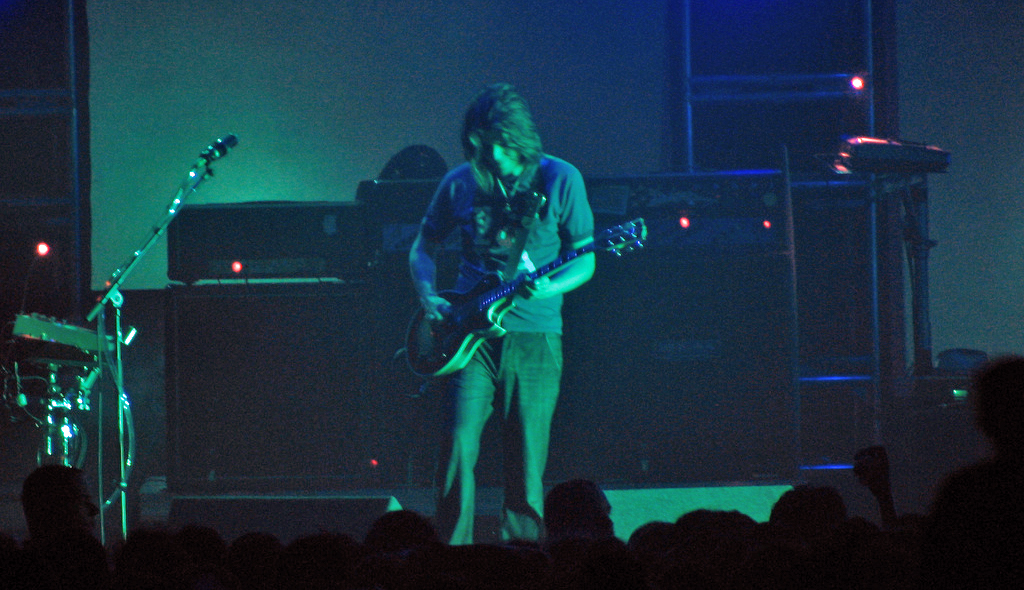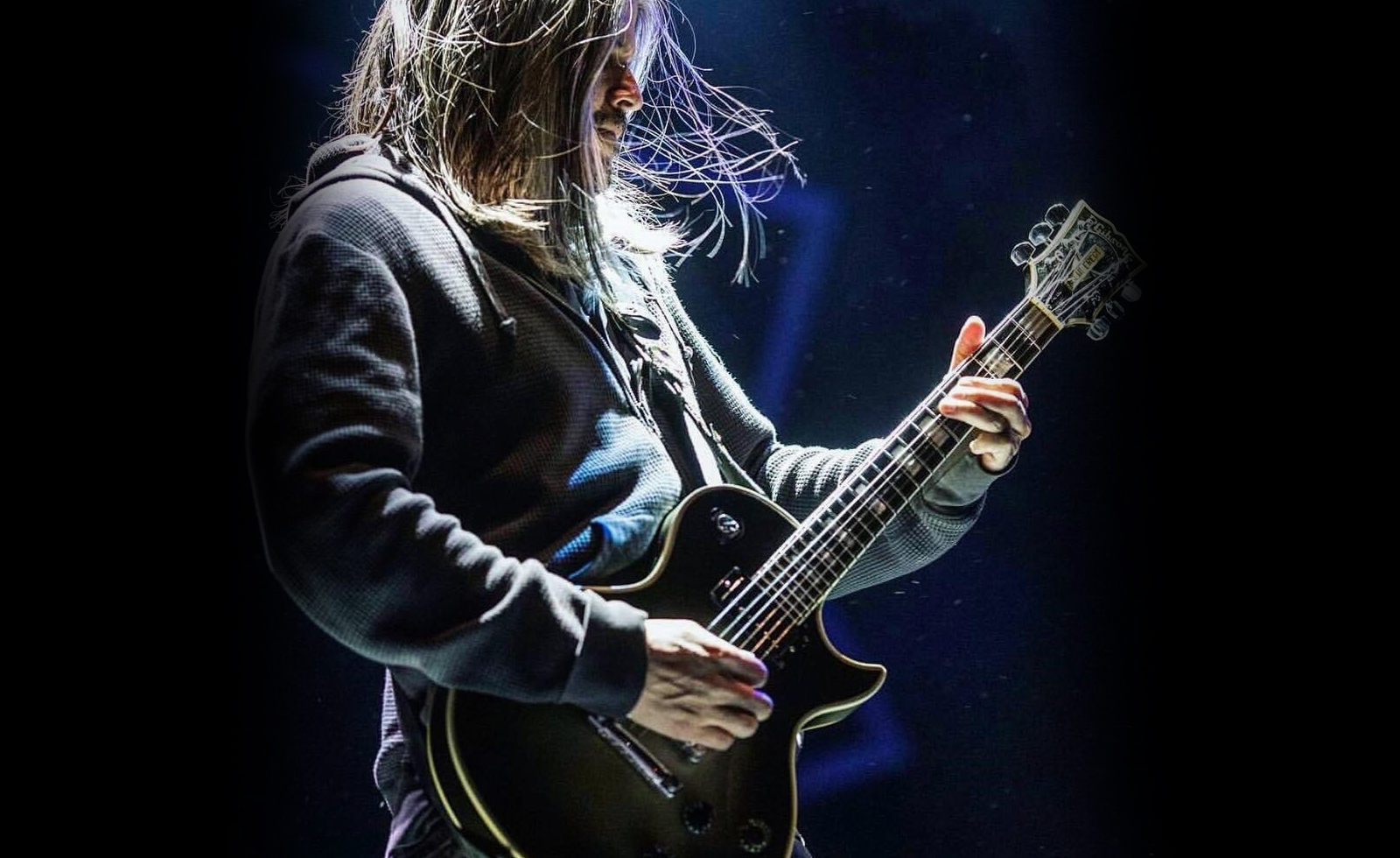Guitars On A Budget
Epiphone is your go-to here for the thick Custom Les Paul tone. The black Custom Les Paul is an obvious starting point and is kitted out with some excellent ProBucker Custom pickups, pro level Grover tuners and the quintessential gold Tune-O-Matic bridge. The Epiphone Inspired By Gibson Les Paul Custom is a step up in build quality and appointments, with Gibson USA 490R, a ’50s rounded “C” neck and a maple cap to the body.
If you’re willing to spend more on the guitar and you’re a huge fan of Adam Jones, or just love a great Silverburst, then the Epiphone Adam Jones signature Les Paul is the only way to go. Built to Jones’ specs, Epiphone have recreated the iconic instrument with Gibson-accurate headstock, CTS potentiometers, Orange Drop capacitors, and have fit a Seymour Duncan Distortion at the bridge and a Gibson Burstbucker in the neck position. The neck is also a custom appointment – a tapered profile that matches his 1979 Custom.
The premium choice of guitar to get Tool tones is the Gibson Jones signature LP. Like Jones’ own guitars, this one isn’t weight-relieved. It’s got the same ’70s spec, in terms of the more rounded neck profile, medium jumbo frets and bound maple top. The Gibson BurstBucker in the neck sounds super smooth, while the DC is a high-output monster for the metal punch.
Epiphone Guitars
Browse Epiphone Guitars
Epiphone Les Paul Guitars
Browse Epiphone Les Paul Guitars
Adam Jones’ Amplifiers

Adam Jones’ thick and textured guitar tone doesn’t just come from one amp, but three! As the sole guitarist in Tool, it has always been necessary for him to achieve a massive, stadium-filling guitar sound. And by running through three amplifiers, it allows Jones to cover almost every area of the guitar’s frequency spectrum.
His modified mid-seventies Marshall Super Bass 100 has been a mainstay since the very beginning, with its two channels wired together to create a more aggressive and saturated high-gain sound. This Marshall was used extensively for recording on Tool’s debut album Undertow.
It wasn’t until their second album that Jones started experimenting with a multi-amp rig, throwing a Mesa Boogie Dual Rectifier into the mix as well as a Diezel VH4 amp head. Forming a more three-dimensional sound, Jones’ tone is noticeably heavier on Ænima. The VH4 could add a richer low-end growl, while the Dual Rectifier injected more gain and top-end fizz.
From the Lateralus era onward, Adam has used his Marshall Super Bass 100 in conjunction with a pair of VH4s (pictured), run through Mesa Boogie cabinets. It has been documented that he employed Bogner Uberschall and Rivera Knucklehead amps when recording 10,000 Days, but his rig has remained much the same for nearly two decades.
Marshall Amps
Browse Marshall Amps
Mesa Boogie Amps
Browse Mesa Boogie Amps
Guitar Amps On A Budget
With a stricter budget in mind, the versatile, valve-driven Marshall Dual Super Lead, DSL for short, is a great starting point to emulate Jones’ Tool tones. The lead channel’s ultra gain mode will get you close. It emits lots of fiery gain and has that iconic saturated Marshall tone, certainly within striking distance of the Undertow aggression. For lighter overdriven Tool tones, like that heard in the verses of Schism, the classic gain mode would be more appropriate. The DSL’s clean channel is also strong, with a warm yet articulate character. Jones doesn’t often use clean tones, but for tracks such like The Patient and Disposition it will more than suffice.
Apart from its two versatile channels, the DSL amp is known for taking pedals well, both through its front-end and its effects loop section. Jones uses a number of stompboxes, so having a decent pedal platform is key. The combo models are also fitted with a punchy Celestion V-type speakers and the wattage options give you plenty of headroom.
Emulating the Mesa Boogie or Diezel is a bit tricker because of their unique tones, but it’s not impossible. The Boss Katana is an all-round brilliant amp that gets you the bassy, scooped high-gain. Another option is to check out preamp pedals like the Victory V4 Kraken or Horizon Devices Apex if you already have an amp you can insert one of these into the effects loop.
Victory Amps
Browse Victory Amps
Boss Katana
Browse Boss Katana
Adam Jones’ Pedals
Adam Jones isn’t considered a pedal junkie like his Tool bandmate Justin Chancellor. However, his live pedalboard does sport a fairly diverse arsenal of effects. Owning a mix of Boss, MXR and DOD pedals, Jones uses pedals in an additive way to enhance his core tones.
Jones employs an old-school DOD FX40B EQ pedal to shape the sound of his amps, boosting their lows for a chunkier character and raising the higher frequency bands for extra clarity. Jones’ MXR Micro Amp functions as a lead boost, which is often used in conjunction with his trusted Jim Dunlop Cry Baby wah; helping him to really cut through in the mix.
For delays, Jones has been a long-time user of the old Boss DD-5 Digital Delay and a BF-2 flanger. He also relies on a Line 6 DL4 Delay Modeller, and it’s safe to assume that he used one of or both pedals to record the ambient guitar parts in Vicarious, Right in Two and Lateralus.
One of the most interesting elements in Jones’ setup is his Roland PK-5 MIDI Controller. Featuring a number of piano-like pedals, he uses this controller to trigger sounds and samples from his Access Virus synth module. Jones also uses an MXR Talk Box pedal, which he uses prominently on the guitar solo in Jambi.
Boss Pedals
Browse Boss Pedals
MXR
Browse MXR
Guitar Pedals On A Budget
The DOD EQ pedal that Jones uses is discontinued and the Boss GE-7 Graphic Equaliser does an equivalent job instead. Very similar in terms of how it works, they adjusted the frequency sliders with the smiley face EQ shape that Jones utilises.
The Boss DD-5 and BF-2 flanger that Jones has are also no longer in production. The Boss DD-3T is slightly simpler than the DD-5, with fewer delay modes to choose from. Regarding how it sounds and its parameters, it can be operated just like the DD-5 and is by far the closest alternative. The BF-3 is a newer, more versatile version of the flanger.
The Behringer Hellbabe is the ideal budget wah pedal offering both vintage and contemporary tones. The TC Electronic Flashback 2 is a highly diverse delay, mirroring the DL4’s extensive tonal capabilities.
Behringer
Browse Behringer
TC Electronic
Browse TC Electronic
Want to Learn More?
If you’re interested in finding out how to achieve the tones of your favourite artists, check out more of our Sound Like articles by clicking here!





Responses & Questions